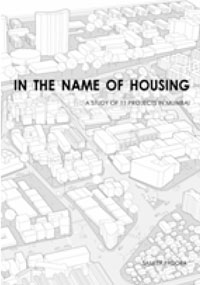Spotlight on Housing
Pooja Ugrani
Tekton
Volume 4, Issue 1, March 2017
pp. 94 – 95
The research and practice of architecture are often seen as isolated entities. It is naively assumed that the skills required for carrying out each are different from one another. These assumptions leave out the possible symbiotic enrichment of the field. Today, timelines of projects in architectural practice are ridiculously short. Hence, background research and initial studies are treated as dispensable rather than requisites for arriving at informed and sensitive design. What comes out of these crunched up processes most of the times are quick-fix designs that leave much to be desired.
In The Name of Housing by Sameep Padora and Associates comes as a welcome change in this context. The project has attempted to reach out to all in diverse ways as an exhibition, a book and most importantly as a pre requisite to a commissioned mass housing project by a practicing architectural firm in Mumbai. This ongoing research project on housing was first displayed in the form of a month long exhibition in 2016 as an allied event of ‘The State of Architecture: Practices and Processes in India’ exhibition.
Through an interesting collection of measured drawings, detailed models and photographs, the display showcased 11 case studies of affordable housing in the city of Mumbai. The exhibition also housed a model of the proposed design of the commissioned project, hinting at how the documentation and analysis of previous works could reach a tangible design solution.
The book is an extension of the exhibition and brings and highlights historical and current models of affordable housing in Mumbai. Be it the Atmaram Chawl with its two front yards or the mixed use building of the Swadeshi Market Chawl that has a cloth trading wholesale market on its ground and first floors and residential chawls in the floors above, each of these models is a native typology that has emerged as a response to the city’s context. These models and the case studies are exhaustively represented with respect to their history, open spaces, social spaces, circulation spaces, built areas and densities. In conclusion, each model is analysed in a manner that places its salient features in the light of the city which suggest possibilities for affordable housing in the future.

In The Name of Housing: A Study of 11 Projects In Mumbai (2016)
Author:
Sameep Padora
Publisher:
Urban Design Research Institute (UDRI)
Pages:
276
Price:
INR 1250
In The Name of Housing questions existing models that use top down approaches in affordable housing such as the ones executed by the SRA (Slum Rehabilitation Authority). These may look feasible on paper in terms of their area requirements but once built they give rise to an inhuman environment with no consideration to social spaces and human interaction. The book helps the readers with a framework to devise alternatives to the unsympathetic apartment format of formal affordable housing being built in the city presently.
The book is intended to function as a handbook to academics, practitioners, students and designers. It could be used for its spatial analysis framework and efficiency studies as a stepping stone to their own design exercises. What makes it all the more enjoyable to engage with, apart from its very relevant content is the interface- spineless binding, colour coded sections and the use of graphics. The book informs about a highly relevant issue in the city of Mumbai with communicative and mixed imagery in the form of abundant drawings, graphs, maps, pie charts etc.
In The Name of Housing documents an important era of Mumbai’s social, user responsive mass housing. It has archived a part of Mumbai’s built history and its architectural value in an original format, a part which is still thriving but under threat thanks to a boom in real estate development. Therein lies its lasting
value for students and architects alike.
Pooja Ugrani
 Pooja Ugrani graduated from Sir J.J. College of Architecture, Mumbai and has a PG diploma in Indian Aesthetics from JananaPravaha, Mumbai. Her areas of interest are urban exploration, architecture through origami etc. Her research explores how human behaviour and the urban built environment impact each other. She is currently pursuing her M. Arch. Degree by research from Mumbai University where she aims to evaluate the expression of ownership at the boundaries of domains in urban mass housing.
Pooja Ugrani graduated from Sir J.J. College of Architecture, Mumbai and has a PG diploma in Indian Aesthetics from JananaPravaha, Mumbai. Her areas of interest are urban exploration, architecture through origami etc. Her research explores how human behaviour and the urban built environment impact each other. She is currently pursuing her M. Arch. Degree by research from Mumbai University where she aims to evaluate the expression of ownership at the boundaries of domains in urban mass housing.

